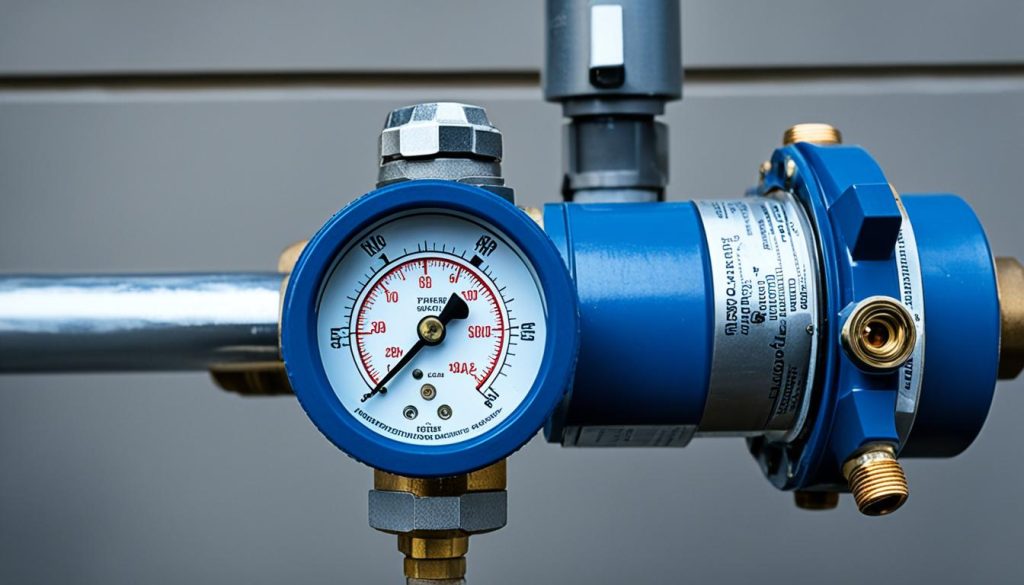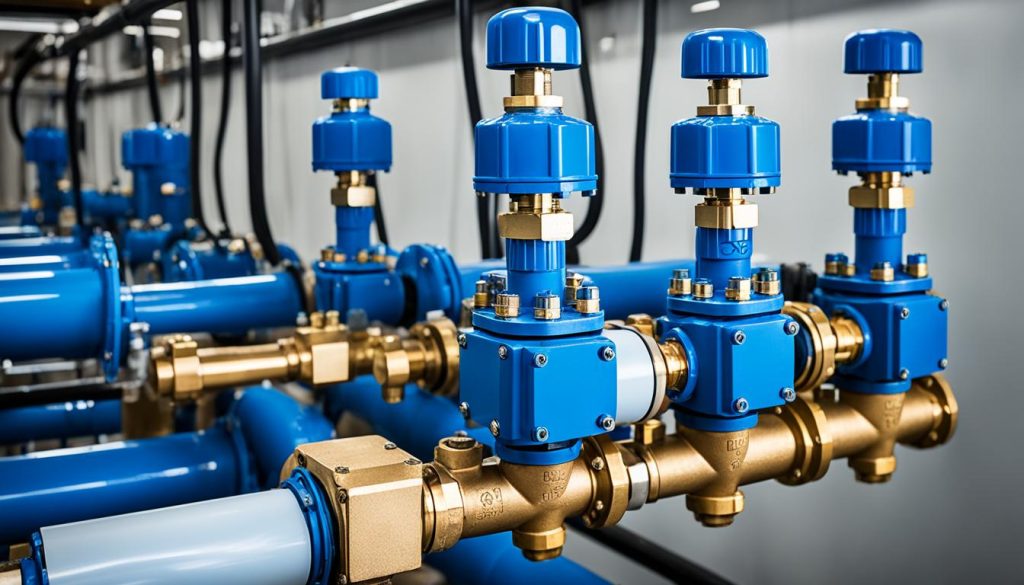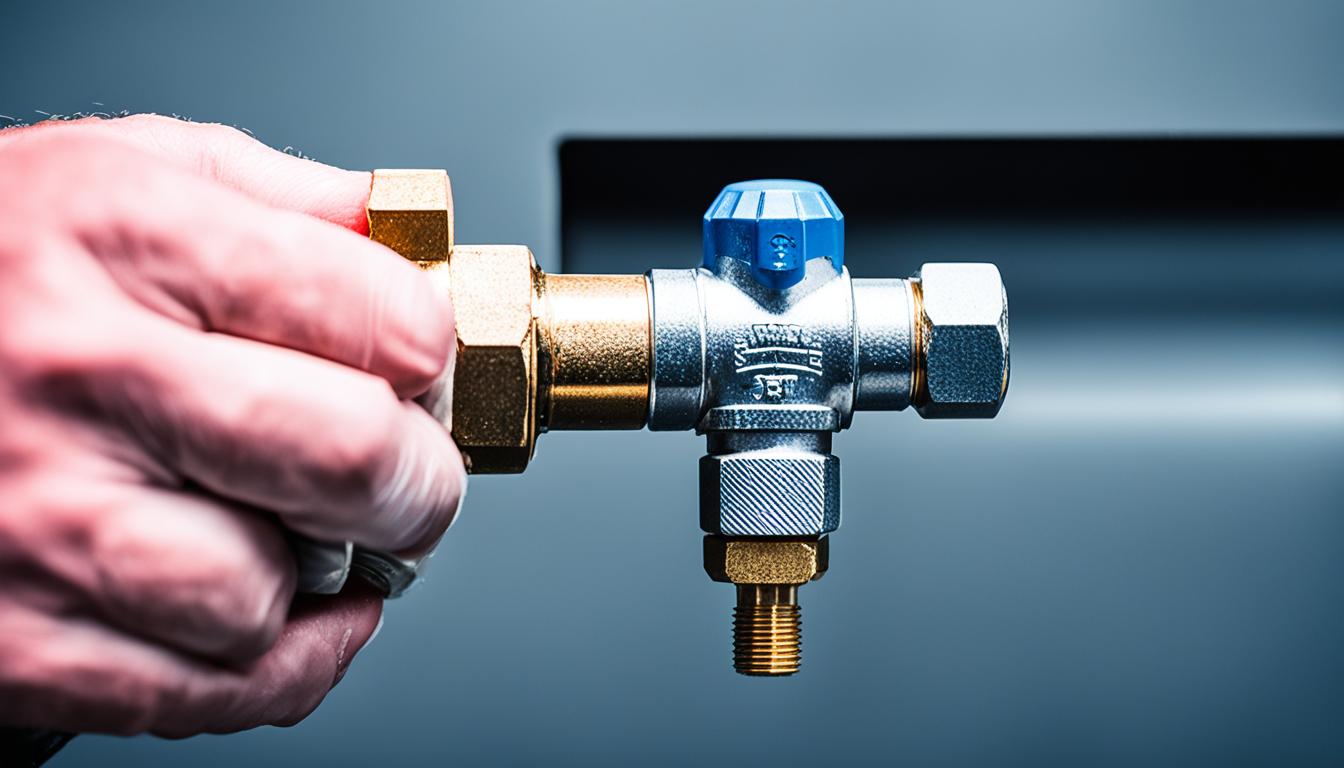Did you know that excessive water pressure can cause damage to pipes, faucets, and appliances, leading to costly repairs and replacements? In fact, according to recent studies, high water pressure is responsible for over 10% of all plumbing failures in residential and commercial buildings.
That’s where pressure reducing valves (PRVs) come in. Also known as water pressure regulators, PRVs are essential devices that help lower and regulate water pressure, ensuring a safe and efficient home water system. By controlling the pressure between the upstream and downstream sides, PRVs prevent damage, conserve water, and maintain consistent pressure.
Key Takeaways:
- High water pressure can cause damage to pipes, faucets, and appliances.
- Pressure reducing valves (PRVs) help lower and regulate water pressure.
- PRVs prevent plumbing failures and extend the lifespan of the plumbing system.
- By controlling water pressure, PRVs conserve water and lower water bills.
- Selecting and sizing PRVs correctly is crucial for optimal performance.
Benefits of PRV Water Pressure Reduction
Lowering and controlling water pressure through the use of PRVs offers several benefits. Firstly, it reduces excessive pressure that can cause damage to pipes, faucets, and appliances, thus extending the lifespan of the plumbing system. Secondly, it helps conserve water by reducing consumption, which can result in lower water and sewer bills. Additionally, by maintaining a consistent and safe pressure, PRVs prevent premature failure of irrigation systems components, such as solenoid valves and sprinkler heads. This not only avoids wasted water but also prevents water hammer and nozzle fogging.
Lowering and controlling water pressure through the use of PRVs offers several benefits. Firstly, it reduces excessive pressure that can cause damage to pipes, faucets, and appliances, thus extending the lifespan of the plumbing system. Secondly, it helps conserve water by reducing consumption, which can result in lower water and sewer bills. Additionally, by maintaining a consistent and safe pressure, PRVs prevent premature failure of irrigation systems components, such as solenoid valves and sprinkler heads. This not only avoids wasted water but also prevents water hammer and nozzle fogging.
| Benefits of PRV Water Pressure Reduction | |
|---|---|
| Reduces excessive pressure | Extends the lifespan of the plumbing system |
| Conserves water | Lowers water and sewer bills |
| Prevents premature failure of irrigation system components | Avoids wasted water |
| Prevents water hammer and nozzle fogging |
Selecting and Sizing PRVs Correctly
When it comes to the installation of Pressure Reducing Valves (PRVs), selecting and sizing the right valve is crucial for optimal performance and water pressure control. PRVs should be chosen based on the type of building, whether it is a residential, commercial, public, or industrial property, and the required outlet pressure range.
One common mistake is assuming that PRVs should be matched to the size of the inlet pipe. However, proper sizing involves considering the required flow rate and the set system pressure to ensure reliable pressure control and prevent issues such as noise and water hammer.
Oversized PRVs can lead to undesired noise and damage the valve seal, while undersized PRVs can result in increased noise and water hammer. Therefore, it is important to choose a PRV that is correctly sized for the specific application to avoid these complications and ensure system longevity.
Proper PRV Selection Process:
- Determine the type of building (residential, commercial, public, or industrial) where the PRV will be installed.
- Identify the required outlet pressure range for the particular application.
- Consult technical experts to choose a PRV model and size that suits the specific project requirements.
- Consider factors such as flow velocity and flow rate to ensure optimal performance.
By following these steps, you can ensure that the selected PRV meets the needs of your project, providing reliable water pressure control and maintaining the longevity of your plumbing system.

| Benefits of Proper PRV Selection and Sizing: |
|---|
| Reliable pressure control |
| Prevention of noise and water hammer issues |
| Extended lifespan of plumbing system |
Staging PRVs for Efficient Water Pressure Control
In certain buildings with high inlet pressures, it is common practice to stage PRVs to ensure efficient water pressure control. Staging PRVs involves using multiple valves to gradually reduce the water pressure instead of relying on a single valve. This not only prevents damage to the PRVs and the plumbing system but also adds an extra layer of protection in case of system failures or complications. By staging PRVs, the risk of cavitation and damage to the valve is reduced, and the overall water pressure control in the building is enhanced.

When it comes to prv installation, water pressure management is a crucial aspect that can greatly impact the efficiency and longevity of a plumbing system. By staging PRVs, the water pressure can be effectively controlled and regulated throughout the building, ensuring a consistent and safe water supply.
Staging PRVs involves strategically placing multiple valves at different points in the water distribution system. Each valve is set to reduce the pressure gradually, allowing for a smoother transition from the high inlet pressure to the desired outlet pressure. This staged approach not only helps to prevent sudden pressure drops but also ensures that the water pressure remains within the recommended range.
One of the key advantages of staging PRVs is the added layer of protection it provides. In the event of a system failure or complications with one of the PRVs, the other valves can continue to regulate the water pressure, preventing potential water hammer or damage to the plumbing system.
The image below illustrates an example of how PRVs can be staged in a building to achieve efficient water pressure control:
| Stage | Location | Setting |
|---|---|---|
| Stage 1 | Main water supply line | Initial pressure reduction |
| Stage 2 | Branch lines | Further pressure reduction |
| Stage 3 | Individual fixtures | Final pressure adjustment |
By strategically placing PRVs at different stages, the water pressure can be effectively controlled and maintained at an optimal level throughout the building. This not only helps to prevent plumbing issues but also ensures a reliable and efficient water supply for various applications.
When considering prv installation, water pressure management should be a top priority. Staging PRVs is a proven method to enhance water pressure control and protect the plumbing system from potential damage. It is recommended to consult with a professional plumber or technician to determine the best staging configuration for your specific building and water pressure requirements.
Choosing the Right PRV for Your Project
The selection of a pressure reducing valve (PRV) is a critical decision when it comes to managing water pressure in your project. Several factors need to be considered to ensure optimal performance and water pressure control.
Firstly, the type of building and its specific needs play a significant role in determining the right PRV. For domestic installations, compact PRVs that can adjust to pressures between 1.5 and 6.0 bar are suitable. On the other hand, larger commercial or industrial projects may require PRVs with higher flow rates and pressure adjustment capabilities.
It is also important to consider the required outlet pressure range, flow velocity, and flow rate. These factors will help determine the appropriate PRV model and size for your application. Consulting with technical experts can provide valuable guidance on PRV selection and installation best practices.
By choosing the right PRV for your project, you can ensure efficient water pressure control, prolong the lifespan of your plumbing system, and avoid unnecessary costs associated with excessive pressure or water consumption.
